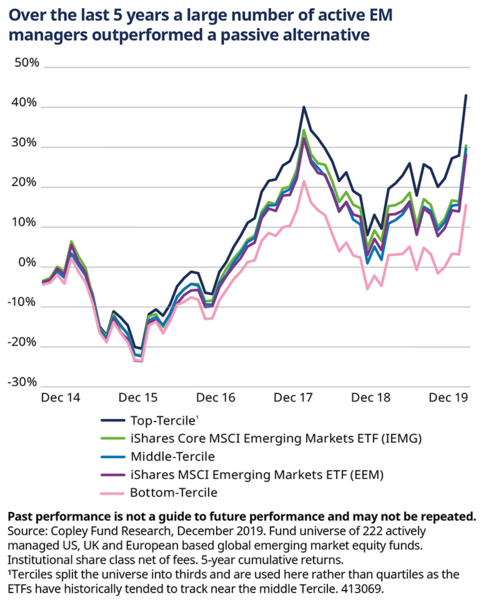Why active trumps passive in emerging markets
Passive approaches to emerging market equities have gained in popularity in recent years, but we believe that the case for active remains compelling.

Authors
Investors have been debating the benefits of active versus passive management for many years. In certain asset classes passive managers appear to have won the argument. In large cap US equities, for example, passive now accounts for an estimated 55% of fund assets under management, up by more than a third in just seven years.
In emerging markets (EM), however, the debate continues.
In our paper, which is available in full at the bottom of the page, we review the evolution of EM equities over a 30-year period in which much has changed.
We also build an accurate picture of the costs and benefits of an active approach to EM investing over a passive approach.
We show that even though the costs of passive have fallen dramatically, the case for active remains compelling.
Here’s a short summary of our paper.
Listen to Kirsty McLaren’s podcast, discussing her key findings
The evolution of emerging markets
Over the last 30 years, EM equities have provided positive long-term risk-adjusted excess returns. They’ve also played an important role in diversifying portfolios.
However, a large degree of patience and a long investment horizon have been required; there have been long periods when EM equities have underperformed developed market equities. In addition to the volatile performance ride, the opportunity set for an EM equities investor has changed dramatically, as developing countries have opened their markets to foreign investors and enhanced their operational and regulatory regimes.

Why the cost of beta has fallen
The costs of EM equity exchange traded funds (ETFs) vary, but in general they benefit from economies of scale. The larger the ETF, the higher the average daily volume (ADV) tends to be. Higher ADVs usually mean tighter bid/offer spreads as there are more secondary market transactions. Many EM equities ETFs also reduce their ongoing total expense ratios (TERs) and their tracking errors through securities lending programmes. The proceeds help to offset lower management fees, and some fraction of them may also be shared with the ETF itself. Costs have fallen over time as ETF providers have pursued market share and their AUM have increased.
The case for active management in emerging market equities
Over the last 20 years, the diversity of opportunities within EM has consistently led – both at the country and at the security level – to high cross-sectional return dispersion. That is to say, the distribution of all of the individual index stock and country returns has been wide.
This potentially creates opportunities for active managers to add value through country allocation and stock selection.
We show that systematic factors such as Value and Size are not consistent predictors of performance across time, and highlight the difficulties of a passive approach to ESG investing. That leaves room for fundamental active managers to add value in EM above the available market index return.
Market structure is a further argument for why emerging stock markets can be fertile ground for active managers. The higher share of retail participants in EM stock markets should be positive for fund managers with active investment processes.
How does performance record of active versus passive stack up?
Over the most recent five-year period, a large number of active managers outperformed the passive products that most investors can access, net of institutional fees. Indeed, the fund selection challenge needs to be reframed. Rather than trying to pick the top-performing fund, investors should try to avoid the worst performing funds. This is potentially a much more achievable task for investors who are able to conduct due diligence on managers.

However, it’s not always plain sailing right from the start. Our research shows that you need to hold a fund for more than a year, and preferably up to three years, before it starts to outperform reliably. (The exception to this was the global financial crisis when active managers underperformed, and took a long time to recover.)
An investor needs to have conviction that a manager’s investment process can deliver alpha, and confidence that the manager is sticking to that process.
The performance discussion is centred on institutional investors who are able to choose from a global set of managers and to undertake due diligence on potential fund investments. For retail investors, the situation is slightly different but our broad conclusions remain valid.
Authors
Topics